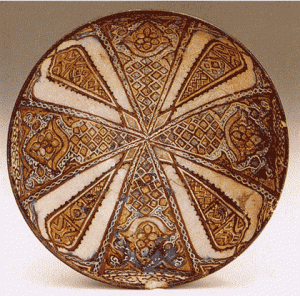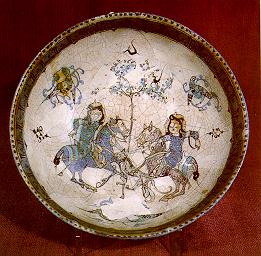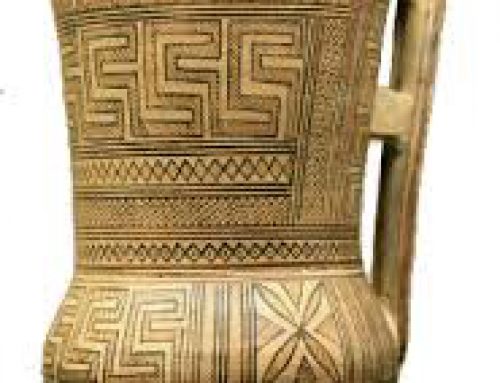
A tin-glazed plate
Just about the time of the Arab conquests (about 600-700 AD), potters started to use metal-based glazes on their pots. So Islamic pottery looks very different from the Roman pottery that came before it.

Tin-glazed bowl imitating Chinese pottery, ca. 850 AD
West Asian potters invented this way of glazing pottery during the Roman Empire, but Roman potters didn’t use it very much. Glass glazes became much more popular during the early Abbasid empire, about 800 AD. That’s because the glass glaze gave potters a way to copy white Chinese porcelain. Traders were bringing Chinese porcelain west to sell in Baghdad. But it was very expensive. Local knockoffs in glazed pottery were cheaper.

From around 1400 AD
Islamic potters then began to experiment with lots of different glazes. They painted one color over another, and sometimes fired the pottery more than once.

From about 1300 AD
When the Mongols conquered Central Asia and China in the 1200s AD, there was even more trade between West Asia and China. Chinese pottery again became fashionable in West Asia, and a lot of West Asian pottery copied Chinese colors and patterns.
Learn by doing: make a clay pot and glaze it
More about Islamic Art
Bibliography and further reading about Islamic pottery:
Eyewitness: Islam, by Philip Wilkinson and Batul Salazar (2002). 1. For kids – the religion and culture of the Islamic Empire, with lots of pictures.
Pottery of the Islamic World: In the Tareq Rajab Museum, by Geza Fehervari (1998). A good representative collection, with many outstanding pieces, well illustrated.
Pottery of the Early Islamic Period, by Charles Wilkinson (1974). Relies on the collection of the Metropolitan Museum in New York.




